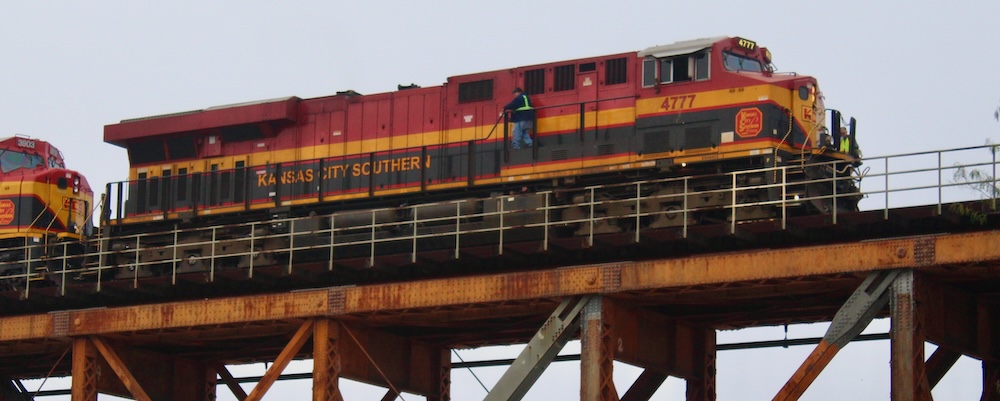
CHICAGO — Freight train operations across the U.S.-Mexican border should be as seamless as they are across the U.S.-Canadian border, Union Pacific CEO Jim Vena told a shipper group last week.
Cross-border trains entering the U.S. from Canada use Canadian crews to reach the nearest rail yard — and vice versa. “I never used to even think about the border when I worked at Canadian National Railways,” Vena told the North American Rail Shippers annual conference.
But it’s a different story at gateways to and from Mexico. In most cases, cross-border trains stop on bridges over the Rio Grande to swap crews. It’s a time-consuming process as crews must walk to and from their trains from their respective sides of the border. It’s also a security and safety risk as trains are strung out through border communities.

“In Mexico, we need to get over this issue of stopping at the border and changing crews on bridges,” Vena says.
Mexican crews should meet the same training standards as U.S. crews so that they can bring trains into the first yard in the U.S., and American crews should have the same ability to deliver trains into yards in Mexico, Vena says.
Doing so would improve fluidity at the single-track border crossings. “We should be able to build traffic in Mexico that’s coming northbound that comes onto our network with a Mexican crew that comes across the border,” Vena says. “Our crew gets on and we don’t stop.”
Canadian Pacific Kansas City, UP, and CPKC de Mexico use international crews to operate a handful of the two dozen trains that cross the border at Laredo, Texas, each day. It’s the busiest rail gateway to and from Mexico.
CPKC international Mexican train crew employees have an average of more than 20 years of experience, according to the Association of American Railroads, and are licensed by the Mexican government to operate trains. They’re also trained and tested on U.S. operating rules and regulations and are required to pass random drug tests, with CPKC de Mexico crews operating within the U.S. subject to Federal Railroad Administration drug and alcohol testing requirements for foreign crews.
The use of international crews at the Laredo border crossing has drawn opposition from rail labor, which views it as a threat to U.S. jobs as well as a safety risk.
But railroads say the introduction of international crews has not reduced hours, jobs, or compensation for U.S. rail workers. Using international crews has reduced train idle time by about a third at the Laredo border crossing, according to U.S. Customs and Border Protection data.
Vena says he’s made 10 trips to Mexico since becoming CEO in August 2023. To work on improving border fluidity as well as keeping rail gateways open during migrant surges, Vena has met with government and customs officials, as well as executives at Ferromex, the Mexican railroad in which UP has a 26% stake.
“Hopefully sooner rather than later we’ll fix that so that we can move traffic fluidly across the border,” Vena says.
Considering the proxy contest at Norfolk Southern — where activist investor Ancora Holdings has questioned the railroad’s resiliency strategy — Vena was asked whether keeping a buffer of crews, locomotives, and freight cars clashes with the principles of the lean Precision Scheduled Railroading.
“We need to have a buffer of people, assets, and capacity to be able to handle the ups and downs that happen in the railroad business,” Vena says, noting that the number of cars customers release on weekends drops by 30% compared to weekday volumes.
The railroad also needs a buffer to meet unanticipated spikes in demand or to help operations recover from harsh weather or the impact of derailments.
“At the end of the day we need a certain amount of buffer. Now, having 1,500 excess locomotives, that’s a little bit too much of a buffer,” Vena says. “But having a couple hundred — and we have 500 right now ready to go — is a smart thing to do.”














Once the 2nd bridge at Laredo is finished then crews could swap trains at the border and mostly would not have to walk the bridge.
BNSF crew take Canadian cars/trains into Canada at (Noyes,MN) and have done it for years. Changing crews on a bridge is a safety hazard.
Ed Burns
38 years retied clerk NP BN
BNSF from Minneapolis, MN
I don’t see where it says the crew bringing a train across the border picks up a train to take back, although that too might be efficient. If US crews take trains into Mexico under the same rules, I can’t see why this would cause any loss of work for the union workers.
“The use of international crews at the Laredo border crossing has drawn opposition from rail labor, which views it as a threat to U.S. jobs as well as a safety risk.”
So Mr. CEO, go talk to your union leads and get it on the agenda for the next labor contract. Sheesh.
Obviously they don’t see Canadian crews as a threat, so why Mexican? Pay scale perhaps?
I assume the pay scale is the underlying issue as well, especially UP and BNSF crews, that are truly interchanging traffic between separate railroads and don’t believe it is really much different than CPKC trains crossing the border at end of day.
..
Of course, transferring crews at nearest respective yards makes way too much sense with US now largest trading partner (Mexico overtaking China recently if not mistaken) as well as makes too much sense from safety and security perspective.